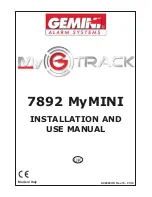
JP14-R-LP & JP14-Q-LP F
ALCOM
GPS R
ECEIVERS
V
ERSION
1.0.0
Ball
Name
I/O
Description
Level
26
TIMERSYNC
O
Control outputs. Do not use, leave it open.
CMOS
27
SPI_EN
I
Control-line for production test. Do not use, leave it open.
28
SPI_CLK
I
Control-lines for production test. Do not use, leave it
open.
29
NADC_D
I
Do not use, leave it open.
30
SPI_DATA
O
Control-line for production test. Do not use, leave it open.
31
NSRESET
I
Do not use, leave it open.
CMOS
32
GND
33
GND
34
GND
Digital grounds
0 V
35
GND_RF
Analogue grounds
0 V
36
RF_IN
I
GPS signal from connected antenna
50 Ohms @ 1.575 GHz
37
NC
38
NC
39
NC
40
NC
-
Not connected
-
Table 2:
Pin assignment of the JP14-Q
6.3 Configuration and timing signals
M-RST
This pin provides an active-low reset input to the
board. It causes the board to reset and to start
searching for satellites. If not utilized, this input pin
may be left open.
T-MARK
This pin provides 1 pulse per second output from the
board, which is synchronized to within 1 microsecond
of GPS time. The output is a CMOS level signal.
BOOTSEL
Set this Pin to high (+3.3 V DC) for reprogramming the
flash of the JP14-R-LP/Q-LP (for instance updating a
new firmware for the JP14-R-LP/Q-LP).
6.4 Serial communication signals
The board supports two full duplex serial channels. All serial connections are at
CMOS level. If you need different voltage levels, use appropriate level shifter, (e.g.
MAX 3232 from Maxim) in order to obtain RS232 compatible signal levels (see also
chapter 9). All supported baud rates can be controlled from the appropriate
screens in SiRFdemo software. You can directly communicate with it through a PC
serial port.
SDI1
This is the main receiving channel and is used to
receive software commands to the board from
SiRFdemo software or from user written software.
SDI2
This is the auxiliary receiving channel and is used to
input differential corrections to the board to enable
DGPS navigation.
Note that, the current operating
firmware does not support DGPS
.
SDO1
This is the main transmitting channel and is used to
output navigation and measurement data to
SiRFdemo or user written software.
SDO2
For user’s application (It is not supported by default
GSW3.1.0).
This confidential document is the property of FALCOM and may not be copied or circulated without permission.
Page 21













































